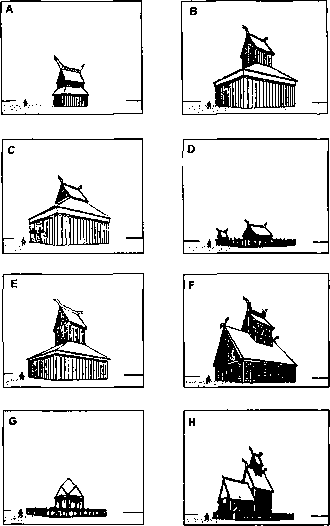image008


Fig. 4. Possible reconstructions of the tempie in Old Uppsala, drawings based cm: A.-C. Schuchhardfs plan of the alleged traces of the tempie in Arccma; B, C, E, F - the description of the tempie in Arcona by Saxo Grammaticusj G - the description of Rugevit’s tempie in Garz by Saxo Grammaticus; O. Olsen, 1970, p. 267.
poles with nails stuck into them. They are called god’s nails (reginnaglar). Inside there was the place of peace (fridstadr).

Fig. 5. A Scandinavian hof. The cult hall in Hofstadir. A - the outline of an elongated fire-place; B - the feast room (skńlt) with a fireplace in the middle and benches at the walls; C - afhus, the place where statues of gods stood at the altar (stallr); P - the entrance; G - the hollow in front of the building where meat for feasts was prepared (seythir); O. Olsen, 1970, p. 273.
Farther from the entrance, towards the morę remote gable wali, there was a room similar to the choir in churches nowadays.
There was a platform {stalli) in the middle of the floor, like an altar. On this altar lay a bracelet, madę in one piece, which weighted twelve ounces. Ali oaths had to be swom on it. The hofgodi had to we ar the bracelet on his arm during all assem-bUes. UsuaUy there was also a bowl for offerings on the altar.” Near it there was an oblation brush, a kind of aspergiUum, used for sprinkling the blood of sacrificed animals, which was called the oblation of blood. “In the afhus, around the stalli, statues of gods stood. Everyone was ob-Uged to pay taxes to the hof and follow the hofgodi in his journeys, just as thingmen are obliged to foUow chieftains nowadays.” But the godi was supposed to maintain the hof at his own expense. The godi, the priest, chieftain and judge, led aU the rituals held there. Near the tempie in Thorsness there was a high mound of rock, worshiped and caUed the Holy Mountain (HelgafeU). Thorolf wished to be buried there. “In the place where the effigy of Thor touched the land, on the narrow cape, he ordered to hołd aU trials and estabUshed the thing for the whole district {heradsthing). This area was so sacred for him that he did not aUow to sully it neither by bloodshed, nor by anyone relieving himself.” For those purposes a smaU rocky island was reserved. Many of the above details were drawn from the pagan Ulfljofs Law, (Olsen 1966, p. 34-35; Strómback,
1975, p. 40). A similar description can be found in Kjalnesinga saga ( ch. 2).
The sagas (Hrafnkelssaga Freysgoda, ch. 2, 6; Hardar saga ok Holm-veria, 1908, p. 79-80; Baetke 1937, p. 5-7) mention several similar edifices,
19
Wyszukiwarka
Podobne podstrony:
image055 Fig. 39. Starigard (Oldenburg). The sanctuary erected after the destruction of the church i
image038 a Fig 10 Idea of the “World tree" as the “World axis" implemented m settlements o
S5002323 261 Fig 3. Axonometnc reconstruction of building 0/87-1, its Southern front and lateral vie
image054 Fig. 36. Starigard (Oldenburg). The location of the stronghold; after M. Muller-Wille, 1988
image018 Exterior septorum ordo Fig. 11. Niederle’s reconstruction of the tempie in Arcona based on
image042 Fig. 18. The topography of the early-raedjevaj Wolin. A - the presumed location of the temp
image048 Fig. 24. Gross Raden. A graphic reconstruction of the settlement in phase A (9th century);
image049 1 m Fig. 26. The profile and plan of the remains of Ihe south-ea&tem wali base of the t
image007 Fig. 3. Old Uppsala. Alteged traces of the tempie under the church foundations; from F. Oel
image017 Fig. 10. The plan of the stronghold m Arcona reconstructed by H.Berlekamp and J.Herrmann. A
image023 Fig. 15. Korzenica-Garz. I, II, m - the alleged traces of temples in the stronghold; after
image047 Fig. 22. The location of the stronghold in Gross Raden. 1 - the stronghold in Gross Grónow;
image078 Fig. 66. The sanctuary in Rzhavintse. Top: a plan of the stronghold with sounding excavatio
S5002146 gp c [1 frag., Fig. 20:6), D [4 1 Fig. 20:2,3], H [1 frag.]. >n was carried out in the a
13 Research on geographical emironment In the reconstruction of thc past transformations, the most p
więcej podobnych podstron